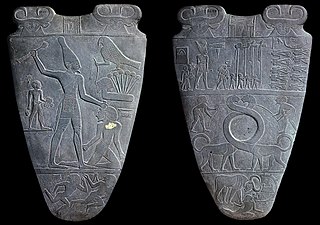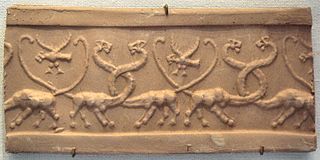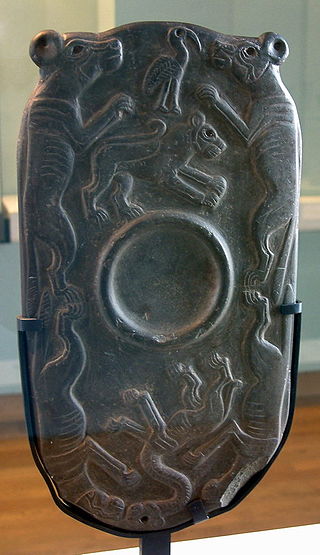Related Research Articles

Narmer (Ancient Egyptian: nꜥr-mr, meaning "painful catfish," "stinging catfish," "harsh catfish," or "fierce catfish;" was an ancient Egyptian pharaoh of the Early Dynastic Period. He was the successor to the Protodynastic king Ka. Many scholars consider him the unifier of Egypt and founder of the First Dynasty, and in turn the first non-mythical king of a unified Egypt. He also had a prominently noticeable presence in Canaan, compared to his predecessors and successors. A majority of Egyptologists believe that Narmer was the same person as Menes. Neithhotep is thought to be his queen consort or his daughter.

The Narmer Palette, also known as the Great Hierakonpolis Palette or the Palette of Narmer, is a significant Egyptian archaeological find, dating from about the 31st century BC, belonging, at least nominally, to the category of cosmetic palettes. It contains some of the earliest hieroglyphic inscriptions ever found. The tablet is thought by some to depict the unification of Upper and Lower Egypt under the king Narmer. Along with the Scorpion Macehead and the Narmer Maceheads, also found together in the main deposit at Nekhen, the Narmer Palette provides one of the earliest known depictions of an Egyptian king. On one side, the king is depicted with the bulbed White Crown of Upper (southern) Egypt, and the other side depicts the king wearing the level Red Crown of Lower (northern) Egypt, which also makes it the earliest known example of a king wearing both types of headdress. The Palette shows many of the classic conventions of Ancient Egyptian art, which must already have been formalized by the time of the Palette's creation. The Egyptologist Bob Brier has referred to the Narmer Palette as "the first historical document in the world".

Nekhen, also known as Hierakonpolis was the religious and political capital of Upper Egypt at the end of prehistoric Egypt and probably also during the Early Dynastic Period.
The Early Dynastic Period, also known as Archaic Period or the Thinite Period, is the era of ancient Egypt that immediately follows the unification of Upper and Lower Egypt in c. 3150 BC. It is generally taken to include the First Dynasty and the Second Dynasty, lasting from the end of the archaeological culture of Naqada III until c. 2686 BC, or the beginning of the Old Kingdom. With the First Dynasty, the Egyptian capital moved from Thinis to Memphis, with the unified land being ruled by an Egyptian god-king. In the south, Abydos remained the major centre of ancient Egyptian religion; the hallmarks of ancient Egyptian civilization, such as Egyptian art, Egyptian architecture, and many aspects of Egyptian religion, took shape during the Early Dynastic Period.

Scorpion II, also known as King Scorpion, was a ruler during the Protodynastic Period of Upper Egypt.

Deshret ( was the Red Crown of Lower Egypt. When combined with the Hedjet of Upper Egypt, it forms the Pschent, in ancient Egyptian called the sekhemti.

The serpopard is a mythical animal known from ancient Egyptian and Mesopotamian art. The word "serpopard" is a modern coinage. It is a portmanteau of "serpent" and "leopard", derived from the interpretation that the creature represents an animal with the body of a leopard and the long neck and head of a serpent. However, they have also been interpreted as "serpent-necked lions". There is no known name for the creature in any ancient texts.

Cosmetic palettes are archaeological artifacts, originally used in predynastic Egypt to grind and apply ingredients for facial or body cosmetics. The decorative palettes of the late 4th millennium BCE appear to have lost this function and became commemorative, ornamental, and possibly ceremonial. They were made almost exclusively out of siltstone with a few exceptions. The siltstone originated from quarries in the Wadi Hammamat.
The Amratian culture, also called Naqada I, was an archaeological culture of prehistoric Upper Egypt. It lasted approximately from 4000 to 3500 BC.

Confronted animals, or confronted-animal as an adjective, where two animals face each other in a symmetrical pose, is an ancient bilateral motif in art and artifacts studied in archaeology and art history. The "anti-confronted animals" is the opposing motif, with the animals back to back.
The Throw stick hieroglyph of ancient Egypt is an old hieroglyph that dates from the Predynastic Period; it is from the assemblage of hieroglyphs used on the ornamental, or ceremonial cosmetic palettes. It is used on the palettes both as a throwing-stick weapon in the animal hunt being portrayed-(the Hunters Palette), as well as on certain palettes, as a determinative referring to a "foreigner", or "foreign territory".

The Battlefield Palette may be the earliest battle scene representation of the dozen or more ceremonial or ornamental cosmetic palettes of ancient Egypt. Along with the others in this series of palettes, including the Narmer Palette, it includes some of the first representations of the figures, or glyphs, that became Egyptian hieroglyphs. Most notable on the Battlefield Palette is the standard, and Man-prisoner hieroglyph, probably the forerunner that gave rise to the concept of the Nine bows.

The Hunters Palette or Lion Hunt Palette is a circa 3100 BCE cosmetic palette from the Naqada III period of late prehistoric Egypt. The palette is broken: part is held by the British Museum and part is in the collection of the Louvre.

The Bull Palette is the fragment of an Ancient Egyptian greywacke palette, carved in low relief and used, at least in principle, as a cosmetic palette for the grinding of cosmetics. It is dated to Naqada III, the final two centuries of the fourth millennium BC, immediately preceding the Early Dynastic Period). It is in the collection of the Louvre, inventory no. E11255.
Manshiyat Ezzat is a village located in the eastern portion of Dakahlia Governorate in Lower Egypt.

The fish palettes of predynastic Egypt are one of the common types of cosmetic palettes, or more specifically zoomorphic palettes, which are shaped in the form of the animal portrayed. The fish palettes are mostly ovoid in shape.
A coronation was an extremely important ritual in early and ancient Egyptian history, concerning the change of power and rulership between two succeeding pharaohs. The accession to the throne was celebrated in several ceremonies, rites and feasts.
Hedju Hor was a ruler in northern Egypt from the Predynastic Period. His existence is controversial. The name Hedju-Hor means The maces of Horus.

Wash was a possible pharaoh from the Predynastic Period. His existence is disputed; if he existed, he is attested to only by his presence on the Narmer Palette, which presumably depicts his defeat.
References
- ↑ Den in the Delta, Nevine El-Aref, Al-Ahram Weekly, Feb 2000 Archived 2009-05-16 at the Wayback Machine
- ↑ Minshat Ezzat palette, (palette corpus)
- ↑ Egypt, The World of the Pharaohs, (photo caption of "Oxford Palette") p 27
- Schulz, Regine; Seidel, Matthias eds.; Egypt, The World of the Pharaohs, (w/ 34 contributing Authors), Konemann, Germany, c 1998, (538 pp). (hardcover, ISBN 3-89508-913-3)